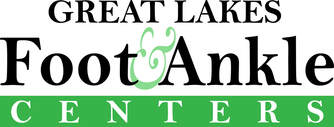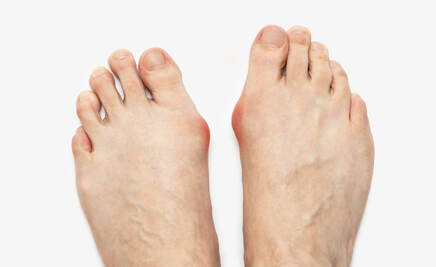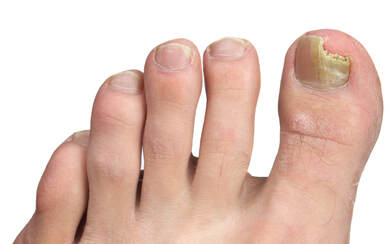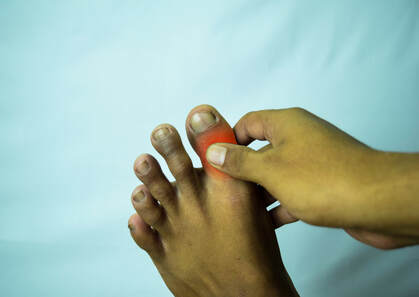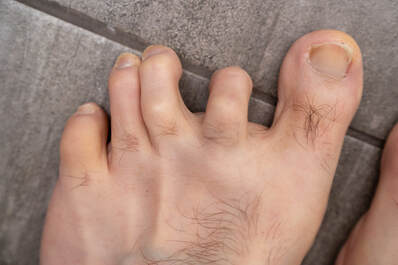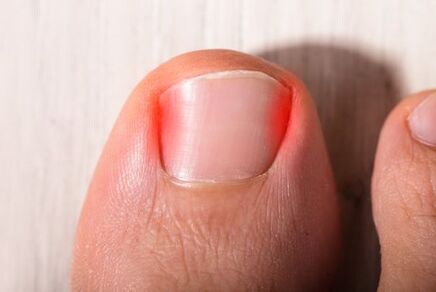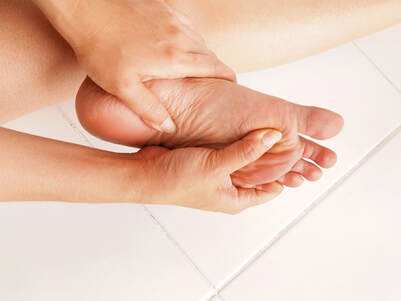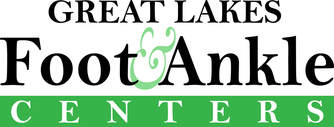Toe Conditions and Treatments
Bunion Deformity
Bunion Deformities: What Are Bunions?
Bunions are bony bumps that can develop on the metatarsophalangeal (MTP) joint, that connects your big toe to your foot. These growths often cause the big toe to turn in toward the other toes. Although bunions are not life-threatening, they can be painful and affect your ability to walk comfortably. Smaller bunions, or bunionettes, can develop on the little toe and result in similar discomfort.
What Causes Bunions?
The exact cause of bunions remains unknown. However, researchers have identified a number of factors that contribute to their growth and development.
Individuals suffering from bunions often report wearing high heels and other tight-fitting shoes. Genetics also appear to play a role in bunion growth as it’s common for these deformities to run in families. Other contributing factors include injuries and other foot problems that lead to inflammation, such as rheumatoid arthritis.
The best way to prevent bunions is to take good care of your feet. Avoid narrow shoes and other ill-fitting footwear. And give your feet a chance to rest after strenuous exercise. If you experience foot pain, consult your doctor early to catch the problem before it has a chance to develop.
Complications
Bunions themselves can be painful all on their own. But they can also lead to complications that only make matters worse. One such complication, bursitis, involves the inflammation of the fluid-filled sacs that normally cushion the bones adjacent to your joints. Corns, hardened layers of skin that the body produces to protect itself from excessive friction, are also common.
Hammertoe, another complication, is characterized by an atypical bend in the middle joint of a toe. It’s common for this complication to affect the toe directly next to your big toe. When caught early, hammertoes are very treatable conditions. But if they’re given time to develop, even surgical interventions may be ineffective.
Metatarsalgia is another common complication for individuals suffering from bunions. Affecting the ball of your foot, metatarsalgia often causes sharp or burning pains. In many cases, resting or icing the foot will relieve the pain. Wearing shoes with arch supports or shock-absorbing insoles can also help.
Bunions are bony bumps that can develop on the metatarsophalangeal (MTP) joint, that connects your big toe to your foot. These growths often cause the big toe to turn in toward the other toes. Although bunions are not life-threatening, they can be painful and affect your ability to walk comfortably. Smaller bunions, or bunionettes, can develop on the little toe and result in similar discomfort.
What Causes Bunions?
The exact cause of bunions remains unknown. However, researchers have identified a number of factors that contribute to their growth and development.
Individuals suffering from bunions often report wearing high heels and other tight-fitting shoes. Genetics also appear to play a role in bunion growth as it’s common for these deformities to run in families. Other contributing factors include injuries and other foot problems that lead to inflammation, such as rheumatoid arthritis.
The best way to prevent bunions is to take good care of your feet. Avoid narrow shoes and other ill-fitting footwear. And give your feet a chance to rest after strenuous exercise. If you experience foot pain, consult your doctor early to catch the problem before it has a chance to develop.
Complications
Bunions themselves can be painful all on their own. But they can also lead to complications that only make matters worse. One such complication, bursitis, involves the inflammation of the fluid-filled sacs that normally cushion the bones adjacent to your joints. Corns, hardened layers of skin that the body produces to protect itself from excessive friction, are also common.
Hammertoe, another complication, is characterized by an atypical bend in the middle joint of a toe. It’s common for this complication to affect the toe directly next to your big toe. When caught early, hammertoes are very treatable conditions. But if they’re given time to develop, even surgical interventions may be ineffective.
Metatarsalgia is another common complication for individuals suffering from bunions. Affecting the ball of your foot, metatarsalgia often causes sharp or burning pains. In many cases, resting or icing the foot will relieve the pain. Wearing shoes with arch supports or shock-absorbing insoles can also help.
|
Diagnosis
Signs of bunion deformity include pain and drifting of the great toe toward the second toe. Other signs include slight swelling, redness, and, in some cases, acute inflammation. |
Treatment
Conservative treatments for bunions include shoe modification, padding, and orthoses (shoe inserts). We rely on these nonsurgical treatments whenever possible. For more serious cases, bunion surgery may be necessary. The surgical procedure may simply realign the big toe joint or remove the growth without aligning the joint. And in some cases, the joint may be removed entirely and replaced screws or metal plates. |
Getting Help
At Great Lakes Foot & Ankle Centers, we have seen and treated countless bunions in Racine, Kenosha, and the surrounding areas. As a result, we know when to move on from non-invasive procedures to surgery. If you’ve noticed a bunion growing on your foot, give us a call today to schedule an appointment.
You can reach our Racine office at 262-884-0944. Otherwise, touch base with our bunion specialists in Kenosha at 262-652-3668.
At Great Lakes Foot & Ankle Centers, we have seen and treated countless bunions in Racine, Kenosha, and the surrounding areas. As a result, we know when to move on from non-invasive procedures to surgery. If you’ve noticed a bunion growing on your foot, give us a call today to schedule an appointment.
You can reach our Racine office at 262-884-0944. Otherwise, touch base with our bunion specialists in Kenosha at 262-652-3668.
Fungal, Yellowed or Deformed Toenails
Usually when you see fungal, yellowed or deformed toenails, an infection is to blame, and it is often closely connected to athlete’s foot.
The doctors at Great Lakes Foot & Ankle Centers can introduce you to an array of approaches that will help alleviate the problem, especially if it is treated early.
The doctors at Great Lakes Foot & Ankle Centers can introduce you to an array of approaches that will help alleviate the problem, especially if it is treated early.
|
Diagnosis
Although a fungal infection is usually the cause of toenail issues, the staff will want to rule out other causes, such as an injury to the toenail root or bone spurs. |
Treatment
In many cases, over-the-counter medications will work, but prescription care may be needed. |
Hallux Limitus
Stiffness in the big toe is known as hallux limitus, a functional condition that can become a kind of structural deformity.
Great Lakes Foot & Ankle Centers can treat your hallux limitus before it progresses into a degenerative form of arthritis.
Great Lakes Foot & Ankle Centers can treat your hallux limitus before it progresses into a degenerative form of arthritis.
|
Diagnosis
Typically, our staff will physically examine your foot and also use X-rays to look for signs of joint narrowing and bone spurs that, if left untreated, can destroy the joint completely. |
Treatment
Treatments range widely from injections and orthotics to surgery. |
Hammertoes
Hammertoes occur when there is an imbalance between the tendons on the top and on the bottom of each toe, which causes them to contract.
Great Lakes Foot & Ankle Centers can treat both the cause and the symptom, and can even introduce you to curative treatment through surgery.
Great Lakes Foot & Ankle Centers can treat both the cause and the symptom, and can even introduce you to curative treatment through surgery.
|
Preventive treatment
Orthotics, prescribed by our podiatrists, can correct a number of foot problems, including hammertoes. Over time the toes will straighten out and correct themselves. |
Curative treatment
Tendon release through surgery often resolves hammertoe issues. |
Ingrown Toenails
Ingrown toenails are a relatively simple irritation that can lead to infection and bacterial invasion. For diabetics and people who have joint replacements or pacemakers, they can become a danger.
The staff at Great Lakes Foot & Ankle Centers treats ingrown toenails when they are a recurring problem, or if they pose a greater health threat through infection.
The staff at Great Lakes Foot & Ankle Centers treats ingrown toenails when they are a recurring problem, or if they pose a greater health threat through infection.
|
Prevention
The best way to prevent ingrown toenails is to trim your nails with clippers and to cut straight across the nail, to not trim the nail too short, and to wear proper shoes. |
Treatment
When necessary, a minor surgical procedure can remedy the situation. |
Sesamoiditis
Sesamoiditis is an inflammation in the sesamoid bones in the big toe, usually connected to heavy activity such as running, jumping from a great height, ballet, or other pursuits.
Great Lakes Foot & Ankle Centers can help reduce the inflammation, which will lessen the pain, and can direct you to long-term therapies that will treat the causes.
Great Lakes Foot & Ankle Centers can help reduce the inflammation, which will lessen the pain, and can direct you to long-term therapies that will treat the causes.
|
Diagnosis
Diagnosis entails a review of your personal history and a thorough examination. X-rays may be needed to tell the difference between sesamoiditis and a sesamoid fracture. |
Treatment
Initial treatments include rest, ice, medications, and physical therapy. |
